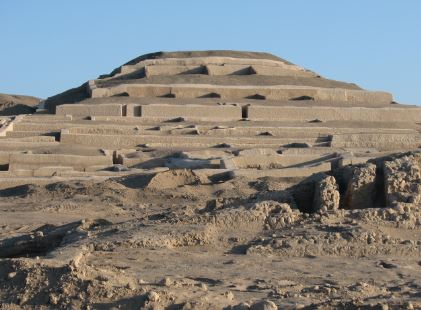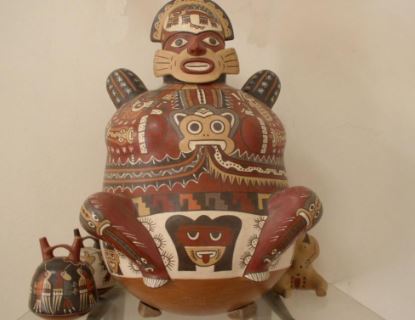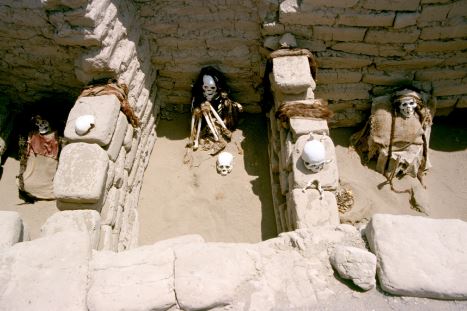Developed between 200 B.C. and the year 600 of our era, the Nazca culture was established in the Peruvian region of Ica. Its capital, Cahuachi, was on the banks of the Aja River, and from there its influence radiated as far as Pisco in the north, and to Arequipa in the south. They also expanded towards the east, reaching the high zones of Ayacucho.
The German archaeologist Friedrich Max Uhle was the one who discovered the Nazca culture, in the year 1900. With findings made in Ocucaje (a district of the department of Ica), Uhle identified the origin and the typologies of this culture, that which he called Proto-Nazca, and that which settled previous to the expansion of Tiahuanaco (today Tiahuanaco-Huari). He also supposed a strong influence from the earlier Topará culture (Paracas Necropolis), which developed in this same territory; both had the same traditions and used the same agricultural techniques. Both were also military cultures.

The Ancient Nazca Culture
Geographical location of the Nazca culture
The Nazca society developed in one of the most difficult zones of Peruvian territory; with a subtropical climate, arid with deserts which surround the small valleys of the department of Ica, like the Rio Grande, Ica, Pisco; these rivers dry up in summer and increase their water level in winter, which determines the geographical landscape which the Nazca population inhabited. From these zones they expanded to the Chincha Valley, in the North; and to the Acari Valley (Arequipa), in the South.
Origin and decline of the Nazca
Archaeology has divided the history of the Nazca culture into four stages:
- Early Nazca: the first Nazca communities which developed in the basin of the Rio Grande appear.
- Middle Nazca: a proper culture takes shape, under the influence of the Paracas Necropolis culture; the ceremonial center of Cahuachi is built.
- Late Nazca: Cahuachi is abandoned, its population spreads, creating new religious centers, the center at La Estaqueria stands out.
- Final Nazca: the decline of the Nazca society begins around 600 A.D., its exact causes being unknown, it is believed that a mix of climatic reverses could have caused the relapse in agricultural activity, or that other warlike peoples may have exterminated them.

The Nazca society was divided hierarchically into social classes. Being a State of the theocratic militaristic type, power was concentrated in the priests and the military leaders who in general were the landowners. This elite had the capacity to organize community work and direct ceremonial activities, they lived in pyramidal buildings, in special sectors whose rooms were made with adobe and walls covered with a layer of gypsum or lime to fill the cracks.
At the service of this leadership were the qualified artisans (ceramists, architects, weavers, astrologists, musicians, soldiers) who lived in small cities and ceremonial centers among which the complex ceremonial center of Cahuachi stands out. At the base of the society were the farmers and fishers. The farmers occupied the fertile valleys, lived in thatched-roof huts situated outside of the cultivated surface, and grouped together in villages around an adobe pyramid which acted as a religious temple.
The Nazca society did not have a unified government, rather it was a group of individual manors. These manors had their own authority who was generally a priest, and they occupied the valleys, in whose extremes were found the settlements, as the rest of the territory along the length of each river was dedicated solely to agriculture. It is generally accepted that the expansion of the Nazca culture was of a military, violent type, primarily because of the existence of fortified cities in the Nazca area, plenty of weapons found in tombs, and the custom of the trophy heads which adorn a great part of their artistic expressions.
Nazca Economy
The Nazca economy was fundamentally based on agriculture, its principal crops being corn, beans, pumpkin, squash, yucca, guava, peanuts, peppers and cotton. Fishing in the sea and shellfishing were of great importance for the inhabitants of the coast who through barter exchanged their products in order to complement their nutritional diet. Hunting was another activity which helped in the Nazca economy.
Trade had vital importance because in this way they could satisfy the necessities of the population often affected by long droughts. They maintained a continuous exchange with the Huarpa culture, who traded products like potatoes and wool in exchange for fish, cotton, and ceramics (craftwork) from the Nazca culture.
They also stood out for their knowledge and use of hydrological resources, especially subterranean ones, which thanks to ingenious projects they utilized for irrigation. Among their principal aqueducts are those of Ocaña, Matara, Aja, Curve, and the Achirana, among others. The underground passages constructed to take advantage of the water tables, in the area where the rivers run underneath the surface receive the name of springs and apparently were the basis of agricultural irrigation for the Nazca inhabitants. Their hydraulic intervention by means of aqueducts, canals, and wells served to provide water for the fields called irrigation canals, proof of which is the construction of the Cantalloc aqueducts and the springs.
Nazca Rituals

The Nazca civilization carried out rituals to their gods of the sea, the sky, the earth, fire, water, and the wind. They carried out their constructions for their gods, with the purpose of avoiding droughts. Their religion also had much to do with the mystery of the Nazca Lines, which are considered by some as a place for numerous rituals offered to their gods.
The funerary burials typical of the Nazca are in general individual, inside a shallow pit. The hierarchy of the deceased could be established by the complexity of the lining of the chamber and the number of objects which accompanied it (vessels, blankets, plumes, hats, bouquets, etc.). The mummy was placed in a fetal position, wrapped in layers of blankets until it formed a bundle, similar to that of the Paracas. Some bundles include the so-called “false head,” a small bulge in the upper part, which simulates a head. The tombs of the men and women of the people are not luxurious, this was a distinct fortune of the nobility.
The mummification of heads was a custom propagated among the Nazca, possibly those of defeated warriors. It was thought that the greater number of heads a warrior possessed, the greater prestige, power and authority he would have. These rites have their origin in the Chavín and Paracas cultures. To make a trophy head, they took out the brain from the base of the skull, then sewed the mouth of the head and made a small hole in the forehead, where they placed a cord to hang them by. The exact purpose of the trophy heads is dim, the most considered has been that the conquering warrior had the right to cut off the head of the defeated enemy and make it into a trophy which he always carried with him. However, the discovery of heads of women and children which are not associated with warrior passages has made it be thought that they may also have been practices linked to the fertility cult.
Chauchilla Cemetery: It is a necropolis from the Pre-Inca era situated some 30 km from the city of Nazca, Peru. Some relate it to the Huari Culture and others to the Nazca Culture which flourished in the area. The mummies are in a good state of conservation in spite of their age and in many of them remains of hair and even some of skin can be seen. This conservation has been possible in part thanks to the arid climate of the Nazca desert in which the cemetery is set.
Artistic expressions of the Nazca
Considered as successors of the Paracas civilization, they stood out for their pictorial, ceramic, and textile creativity. However, it is the famous Nazca Lines which make up their most transcendental legacy. Made up in their entirety by more than 30 drawings of enormous dimensions, they faithfully reproduce zoomorphic, phytomorphic, and geometric figures, among which the hummingbird, the spider, and the monkey stand out. The techniques of tracing employed, which allowed them to continue their lines through hills and ravines without straying from their direction, still surprise the most eminent specialists.
Ceramic
The Nazca ceramics reproduced figures of animals, plants, as well as men and women carrying out everyday activities. In general, they were decorated with mineral paints, carefully ground and mixed with water or sap from local plants. In ceramic productions, figures of mutilated men also stand out, which makes one suppose that they carried out human sacrifices.

The Nazca ceramic is considered to be the best achieved in ancient Peru, for its high quality and variety. Over their ceramics, they painted and decorated the whole surface without leaving blank spaces because of which it is said that they had a “fear of emptiness.” The most typical form of their vessels is the globular jug with two beaks or spillways and an arched handle, they also made spherical pots, mugs, and glasses.
The decoration of their ceramics stands out for its polychromatic nature and its complexity as they used up to eleven gradations of color in only one piece, and they managed some 190 different shades. The motifs are different and can be classified as naturalist, when they draw the environment; mythical or religious, when they show representations of their gods; and geometric, when they use circles, semicircles, rhombuses, lines, spirals, steps, etc.
Architecture
The Nazca architects employed wood, adobe, and the bark itself from the trees to construct their dwellings and ceremonial centers. Using earth kneaded with water they made adobes to construct sanctuaries for the nobility in the shape of a truncated pyramid; the cities of Tinguiña and Cahuachi are an example of this. These last two are displays of urban planning; the first constitutes the best architectural expression; the second was considered to be the capital of the Nazca. In the outskirts of Cahuachi is found the Estaqueria, originally made up of 240 mesquite posts, distributed in 12 rows of 20 stakes in each one, over an artificial platform. Each stake is separated from the next by two meters and they appear to be columns which supported a roof, although its purpose is unknown. Other Nazca urban centers were Tambo Viejo, Huaca del Loro, and Pampa de Tinguiña.

Goldsmithing
They manipulated gold and silver to make masks, ear flaps, nose rings, and other ritual objects, adorned by means of embossing, as they were laminate. These objects were for ceremonial or religious uses.
Textiles
To produce fabrics, they utilized cotton and wool from camelids, mastering the techniques of brocading, tapestry, muslin, painted cloth, tridimensional weaving, and embroidery. Over the flat cotton cloth, they embroidered with wool from camelids dyed with varied colors. The Nazca were heirs of the Topará culture (Paracas Necropolis) in that which is related to the production of extremely refined blankets of cloths, although they did not achieve the same quality and magnificence in the end products.
Music
Musical instruments have been found in the tombs of the Nazca, made of ceramic, they are flutes, trumpets, bass drums, and drums. All these are decorated artistically, many times with anthropomorphic figures, like heads of people, or of animals. The finding of ceramic flutes surpasses all the musical instruments of Pre-Columbian America; these Nazca flutes have 8, 9, 10, and even 11 different notes. They use chromatic scales, which have been used in the present by musicologists to create musical works like the symphony “Las Pampas de Nazca” and the “Danza Nazca” among others.
The Nazca Lines
Appreciable in all their dimensions and form only by flying above the area at high altitude, the lines combine extensive and smooth routes in which circular holes of great depth can be made out. The Nazca made them by following a model constructed on a small scale. Later, over the ground, they traced the lines with stakes joined by cords. The cultural importance of these creations was established by the UNESCO in 1990 when it declared the Lines and Geoglyphs of Nazca and Pampas de Jumana a World Heritage Site.
The Nazca Lines are the most known artistic expressions of the Nazca. They are composed of large designs drawn in the plains of the desert to the north of the settlement of Cahuachi. There were more than 350 of these drawings which can be: anthropomorphic, zoomorphic and phytomorphic figures, in addition to geometric lines several kilometers in length. They were all drawn and created with a precision by which even today the world continues to be impressed.
Some 450 km to the south of Lima and near the Pacific Ocean are found the pampas of Ingenio, Nazca, Palpa, and Socos. Between Palpa and Nazca, in the pampa of Socos, these lines are located, traced on the ground, whose width varies between 40 and 210 centimeters. A semicircle of hills in the distance makes up a gigantic natural amphitheater open towards the West.

Maria Reiche Neuman (1903-1998), from Germany, was considered to be one of the greatest specialists in this culture. After 40 years in the area, she held that the lines were points of astronomical observation useful for agriculture.
Antonini Archaeological Museum
Located in the Peruvian city of Nazca, it exhibits the archaeological heritage of the Nazca area, coming from the works of research carried out by the “Nazca Project” in the ceremonial center of Cahuachi and other important sites in the Nazca River Valley. The Antonini Museum is dedicated to the conservation and study of this heritage. There, one can learn in a very didactic way about the evolution of the Nazca culture, as well as appreciate magnificent ceramics, fabrics, mummies, trophy heads, and many other extraordinary remains of this culture.
